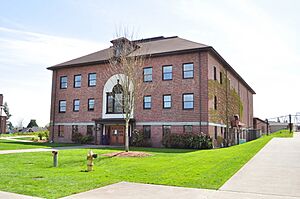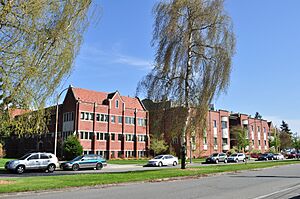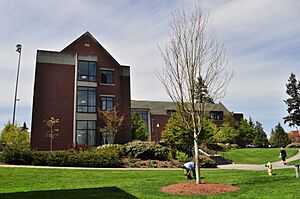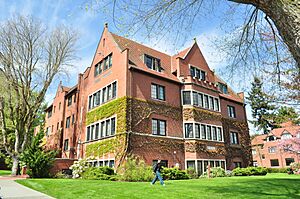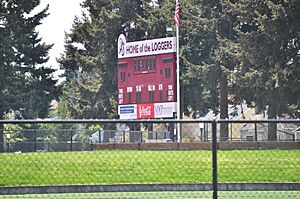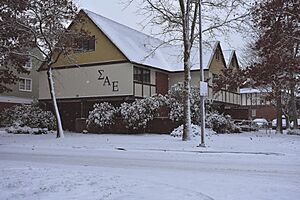University of Puget Sound facts for kids
 |
|
|
Former names
|
The Puget Sound University (1888–1903) College of Puget Sound (1914–1960) |
|---|---|
| Motto | προs τα ακρα (Greek) |
|
Motto in English
|
To the heights |
| Type | Private Liberal arts college |
| Established | March 17, 1888 |
|
Religious affiliation
|
United Methodist Church |
| Endowment | $471.47 million (2024) |
| President | Isiaah Crawford |
|
Academic staff
|
206 full-time; 63 part-time (fall 2021) |
| Students | 2,023 (fall 2023) |
| Undergraduates | 1,712 (fall 2023) |
| Postgraduates | 220 (fall 2023) |
| Location |
,
United States
|
| Campus | Suburban, 97 acres (39 ha) |
| Colors | Maroon and White |
| Mascot | "Grizz" the Logger |
 |
|
The University of Puget Sound is a private college in Tacoma, Washington, USA. It is a liberal arts college, which means it focuses on a wide range of subjects. The university was started in 1888. It offers many different study programs for students. These include programs for a first college degree and also advanced degrees in areas like counseling and health.
Puget Sound's sports teams are called the Loggers. They compete in the National Collegiate Athletic Association's Division III. This means they play against other colleges of a similar size. The University of Puget Sound is special because it has schools for music and business. It is the only independent liberal arts college in the Pacific Northwest with these schools.
Contents
History of Puget Sound University
The University of Puget Sound was founded by the Methodist Episcopal Church in 1888. It started in downtown Tacoma. The idea for the college came from Charles Henry Fowler. He was once the president of Northwestern University. Fowler shared his dream of a Christian learning place in the area.
Choosing a Location
Two cities wanted to be home to the new school: Port Townsend and Tacoma. The committee chose Tacoma. The official start date of the school was March 17, 1888. At first, it was called The Puget Sound University. In September 1890, the school opened its doors to 88 students.
Early Years and Challenges
The college had strict rules in its early days. Students were told to avoid alcohol, gambling, and tobacco. The school also faced money problems. It often struggled to pay its teachers. The university moved three times in 13 years. For a short time, it even joined with Portland University. In 1903, the school was restarted with a new name: the University of Puget Sound.
Growth and New Campus
The school changed a lot under President Edward H. Todd (1913–1942). He worked hard to make the school financially strong. A big fundraising effort collected over $1 million. This money helped the university move to its current location in 1924. The new campus in North Tacoma started with five buildings. In 1914, the school was renamed the College of Puget Sound.
President R. Franklin Thompson (1942–1973) oversaw a huge growth period. Most of the university's buildings were built during his time. In 1960, the school's name changed back to the University of Puget Sound.
Becoming Independent
Phillip M. Phibbs was president from 1973 to 1992. In 1980, the university became independent from the Methodist Church. A new board took over all financial duties. During this time, the school focused more on its main college programs. It sold its law school and most advanced degree programs. The library grew, and more teachers were hired.
When Susan Resneck Pierce became president (1992–2003), the law school was sold to Seattle University. This helped the university focus its money on its main campus. Many new buildings were built or updated. Collins Memorial Library and four academic buildings were renovated. Wyatt Hall was built for the Humanities Department. Trimble Residence Hall was also built, allowing more students to live on campus. Student test scores improved, and the school's money grew a lot.
Ronald R. Thomas was president from 2003 to 2016. He was a scholar of Victorian literature. In 2016, Isiaah Crawford became the new president.
Thompson Hall, where science classes are held, was greatly updated. A new part, Harned Hall, was finished in 2006. The whole project was completed in 2008. This area is now called "The Science Center at Puget Sound." It has a coffee shop inside a cool Plexiglas structure.
In 2013, Thomas Hall opened. This residence hall is for older students. It has 11 "houses" for different study programs. It can house 135 students and has spaces for meetings and events.
University Presidents
- William D. Tyler (1888–1890)
- Fletcher B. Chereington (1890–1892)
- Crawford R. Thoburn (1892–1899)
- Wilmot Whitfield (1899–1901)
- Charles O. Boyer (acting president, 1901–1903)
- Edwin M. Randall Jr. (1903–1904)
- Joseph E. Williams (1904–1907)
- Lee L. Benbow (1907–1909)
- Julius Christian Zeller (1909–1913)
- Edward H. Todd (1913–1942)
- R. Franklin Thompson (1942–1973)
- Philip M. Phibbs (1973–1992)
- Susan Resneck Pierce (1992–2003)
- Ronald R. Thomas (2003–2016)
- Isiaah Crawford (2016-)
Campus Life and Buildings
The campus is in North Tacoma, Washington. It is in a quiet neighborhood, close to local shops and restaurants.
The buildings are mostly made of brick. They are built in the Tudor-Gothic style. Many buildings are grouped around open grassy areas called quads. The main quads are North Quad, South Quad (which have dorms), and Karlen Quad. Karlen Quad has Jones Hall, Collins Memorial Library, and the Music Building.
Main Academic Buildings
Harned Hall opened in 2006. It cost $25 million to build. It was designed to be environmentally friendly. This building has labs for biology, geology, chemistry, environmental science, and physics. It also has a large courtyard with a glass gazebo. Inside, you can see a Foucault pendulum and a Gray whale skeleton named Willy.
After Harned Hall, Thompson Hall was updated. These two buildings together form the Science Center. Thompson Hall was built in 1968 and was renovated in 2008.
Wyatt Hall is one of the newer academic buildings, opened in 2003. It houses many departments like English, History, and Philosophy. Many classrooms are set up for group discussions. The building features beautiful glass art by Dale Chihuly.
Other important buildings include McIntyre Hall, home to the School of Business. Howarth Hall houses the School of Education. Jones Hall has theatre arts and administrative offices. The Music Building is the only one without a specific name. Kittredge Hall, once a student union, now holds the art department and Kittredge Gallery.
Collins Memorial Library has over 400,000 books. It also has many magazines and other resources. The library was named after Everill S. Collins. The current building was built in 1954 and expanded in 1974. A big renovation in 2000 added new technology.
The William T. and Gail T. Weyerhaeuser Center for Health Sciences opened in 2010. This center helps students study health and behavioral sciences. It has programs for exercise science, psychology, and physical therapy. It was also designed to be environmentally friendly.
Academics and Learning
The university offers more than 50 different study areas. These include traditional subjects in the arts and sciences. It also has advanced programs in occupational therapy, physical therapy, and education. A new master's program in public health was recently added. There are 12 students for every teacher, which means students get a lot of personal attention.
College Rankings
| USNWR Liberal Arts College | 95 |
|---|---|
| Washington Monthly Liberal Arts | 80 |
| Forbes | 205 |
In 2012, Puget Sound was listed in Colleges That Change Lives. This guide highlights schools that help students grow in unique ways.
The university has often been ranked among the top small liberal arts colleges. This is for the number of graduates who join the Peace Corps. In 2007, it was ranked first.
Puget Sound teachers have won the Washington State Professor of the Year award seven times. This award recognizes excellent teaching.
Admissions Information
For the class that started in fall 2018, the University of Puget Sound received 5,730 applications. They accepted 3,060 students, which is about 58% of applicants. A total of 653 students enrolled. The average high school GPA for these students was 3.70.
Study Abroad Programs
The university offers many study abroad programs. Students can travel and study in countries like Argentina, Australia, China, England, France, Germany, Japan, and New Zealand.
One special program is the Pacific Rim/Asia Study-Travel Program (PRAST). Every three years, a group of students travels and studies in several Asian countries for two semesters. Students must take courses in Asian studies before joining. Over 40 years, students have visited places like Mongolia, People's Republic of China, Japan, and India.
Sports and Athletics
Puget Sound sports teams are called the "Loggers." Their mascot is "Grizz the Logger." Grizz is a friendly brown bear dressed like a lumberjack and carries a small axe. The Loggers compete in the NCAA's Division III. They play against other colleges in the Northwest Conference.
Varsity Sports Teams
The university has 23 different varsity sports teams. These include men's Baseball, men's and women's Basketball, and men's and women's Crew. They also have teams for Cross Country, Football, Golf, Lacrosse, Soccer, Softball, Swimming, Tennis, and Track & Field. There is also a women's Volleyball team.
Club Sports
Puget Sound has club sports teams too. These include men's and women's club soccer. There is also a men's club lacrosse team. The university has a men's club Ultimate team called the "Postmen" and a women's team called "Clear Cut."
The men's rugby club is very successful. They have achieved regional and national success. In 2012, they were ranked 10th in the nation for small college rugby. They have a strong rivalry with Seattle University's rugby club.
The Puget Sound Loggers hockey team started in 2005. They are an ACHA division II team. They have won against teams like the University of Washington Huskies. Home games are played at Sprinker Ice Arena.
Sports Achievements
Many sports teams at Puget Sound have done very well:
- The men's basketball team won the Northwest Conference championship three times in a row, from 2004 to 2006. In 2005, they beat a Division I team, the University of California, Riverside. In 2009, they had a perfect 16-0 record in conference play.
- The women's Cross-Country team won national championships from 1992 to 1995.
- The women's soccer team placed second in the nation in 2004.
- The women's swim team won the Northwest Conference championship for 11 years in a row, from 1997 to 2007. They won again in 2009.
- The women's basketball team reached the Division III Elite 8 in 2007. They finished ranked 10th overall.
- The women's crew team has competed at the Division III Rowing Championship every year since 2003. They placed second in 2003 and third in 2008.
Student Life and Traditions
Fun Events and Groups
The Repertory Dance Group (RDG) is a popular student group. They put on dance performances at the end of each semester. Students organize, choreograph, and perform all the dances. It has been a tradition for almost 30 years.
In 2013, Puget Sound celebrated its 125th anniversary. There were many special events and programs. The Mayor of Tacoma even declared March 17, 2013, "University of Puget Sound Day."
LogJam! is a campus celebration at the start of the fall semester. Clubs and teams set up tables to find new members.
Foolish Pleasures is an annual student film festival. Students write, direct, act in, and produce all the films shown.
The Hatchet Tradition
The Hatchet is a special symbol for Puget Sound sports teams. It was found in 1906 by students digging up an old barn. Students started carving their class year into it. This became a tradition where older students would pass the hatchet to younger ones. It turned into a fun competition to see which class could keep the hatchet the longest.
The hatchet disappeared for 15 years. It was then sent anonymously to a former president. It disappeared again but showed up at a homecoming game in 1988. In 1998, it was returned and put on display. However, it was stolen again in 1999.
In 2006, a student showed a hatchet at a football game. It was later revealed to be a copy. The original hatchet was finally returned to President Ronald Thomas in 2008 by two former students. It was displayed at Homecoming.
Being Green and Sustainable
The campus has a strong focus on sustainability. In 2005, President Ronald R. Thomas signed the Talloires Declaration. This committed the university to certain environmental standards. A special committee helps organize efforts to be more sustainable.
Some of these efforts include:
- Fair trade coffee: The student-run café only serves coffee that is grown fairly. Puget Sound was the first college in the Northwest to do this.
- Sustainable Move-Out: During finals week, students can easily recycle unwanted items instead of throwing them away.
- Sustainability Mugs: New students receive a reusable mug. This encourages them to use fewer paper cups for coffee.
- No-Waste Picnic: A picnic for new students in 2005 created almost no trash. This was done by using recyclable products.
In 2007, President Thomas signed another agreement to reduce the university's carbon footprint.
Student Groups
The University of Puget Sound has three fraternities and four sororities. Students usually join these groups in their second semester.
Student Media
KUPS 90.1FM (The Sound) is a student-run college radio station. It started in 1968 and broadcasts 24 hours a day. KUPS has been named one of the best college radio stations in the country by The Princeton Review. In 2010, MTV honored KUPS as the Best College Radio Station.
The Trail is the independent student newspaper.
"Crosscurrents" is the school's magazine for literature and art. It publishes student artwork, stories, and poems.
"Wetlands" is a student magazine that explores sexual identity and gender expression. It aims to encourage open conversations on campus.
"Elements" is the student-run science magazine. It features articles about science, research, and technology written by students.
"Black Ice" is a student magazine by The Black Student Union. It focuses on issues important to students of color. The Black Student Union was founded in 1968.
Famous Alumni


